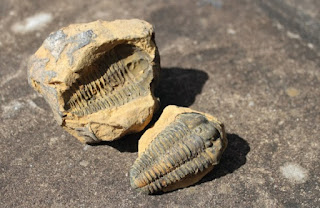The Cambrian Explosion and Trilobite Optics
Despite the assertions of believers in particles-to-paleontologist evolution, their historical science is riddled with problems. Sometimes, they evosplain things away. Other problems are too difficult to easily dismiss.
A couple of days ago, I accompanied my prospector friend Stormie Waters and her pal Ruby Slippers down Texas way. We picked up their supplies and went to the Brittle Star, a restaurant saloon. We talked and watched some folks playing faro. When what to our wondering eyes should appear but Cliff Swallows, the assistant foreman from the Darwin Ranch, and a lady that was new to us.
 |
| Trilobite, RGBStock / Martyn E. Jones |
The trilobite is an icon of the Cambrian layer. It is also a part of the Cambrian Explosion, an informal term indicating that fossils of all sorts of creatures from most major phyla appeared fully formed. Like the brittle star mentioned above, there is no evidence of trilobite evolution (no transitional forms). This child is disappointed that they are extinct, but we'll discuss them more in a bit.
The Cambrian Explosion is a major problem for evolutionists, and they have tried to come up will all sorts of rescuing devices. Why so much effort? Watch the dominoes fall: Observed evidence strongly supports creation science models of the Genesis Flood, Earth is not billions of years old, Papa Darwin cannot perform his wonders and puts on a sad face. So, they circle the wagons and fight off logical conclusions (see "Explosion in the Cambrian" and "Disparity, Diversity, and the Cambrian Explosion" to increase your education). A recent attempted rescue includes possibly disingenuous omissions of scientific facts, and it ignores important details.
A new study of the Chengjiang Biota in Yunnan Province, China, tries to solve the mystery. The authors claim that all the animals died in an unstable river/delta environment. . . .
. . .
Publishing in Nature Communications, the team of scientists from several institutions in China, Canada, and the United Kingdom found an uncommon mix of sedimentary deposits, water sources, and fossil types all mixed in the same rock formation. Some layers show cross-bedding, while others show parallel layering, indicating dramatic changes in flow velocities. Others had “oscillatory-flow” deposits, suggesting water moving back and forth. Some layers suggested shallow water deposition. Other layers in the Yu’anshan Formation contain black shales, rich in preserved organic debris. These are interpreted by evolutionary scientists to have formed in a deep-water setting. In addition, some fossils seem to have been buried in place while others were transported a considerable distance.
To read it all, head over to "Cambrian Explosion Explained by the Flood." Be sure to come back, as we have some interesting things about those trilobites to discuss.
Since the Cambrian is considered one of the oldest layers in the geologic column, creatures should be very simple according to evolutionary reckoning. It is amazing that scientists can determine quite a bit about critters from fossils. Because of advances in science and technology, discoveries in forensic science work against evolution. Trilobites have unique digestive tracts and advanced optics (see "Trilobites Still Troubling Evolutionists.") Further studies of their eyes are inspiring camera lenses!
It seems that one type of trilobite had vision better than that of humans, able to focus on objects both near and very far at the same time. Cameras are limited in their depth of field, but — what would you call this, paleontological biomimetics? — extinct creatures were so well designed, camera lenses are being patterned after them. In fact, it ain't easy.
The remarkable diversity of eyes among trilobites challenges evolutionary theory. . .each type is so different without transitional forms. One particular species had binocular vision with exceptional optics, so unusual that engineers at the National Institute of Standards and Technology (NIST) took a closer look. What they saw challenged them to see if they could achieve similar performance.
. . .
It would be very useful to make cameras with lenses that could focus simultaneously on near and far objects, not only for consumers with cameras but also for the military. Most lenses are limited in their reach of focus, called depth of field. Noting how well this species of trilobite accomplished the feat, NIST engineers set out to make their own version. The result: “metalenses” that could focus on objects as close as 3 cm and as far as 1.3 km – a new record.
. . .
At first, their device was good at focusing at both near and far extremes, but intermediate objects were blurry. Using another bio-inspired trick, they succeeded in focus for the entire range:
If you can see fit to read the entire fascinating article, click on "Trilobite Eye Dazzles Government Engineers."